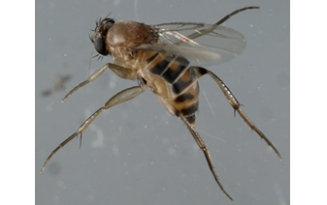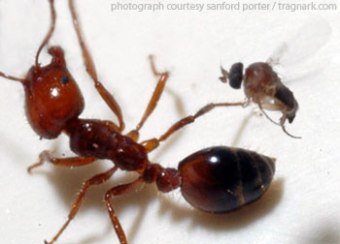For this blog post, we decided to watch a documentary about another member of the Hymenoptera group: the ant. Like bees (as previously discussed in our first blog post), ants too are a social species and their main objective is the protection and survival of the colony. The documentary tilted Ants: Nature’s Secret Power discusses the qualities that make different species of ants successful, but we will only focus on of these aspects: the mutualistic relationships with other insects, such as aphids or carnivorous plants, and their organization of the colony.

Ants with a group of aphids.
Ants manage to attain food by making a “trade” between themselves and other insects. Adult ants require high-energy food and they acquire this through the aid of aphids, insects commonly referred to as plant lice that feed on plant sap and produce honeydew (liquid drops containing sugar). As a result, ants keep a colony of aphids on hand, since they are a consistent supplier of honeydew. In return for food, ants provide a home and protection for the aphids, and in some cases, transportation. Ants, for this reason, are given the label of “herders.” In the case of tropical ants, the “herders” carry their “cattle” to areas where the freshest plant sap is found.

Carnivorous plants, shaped like a jar or pitcher, from the Borneo island.
Another example of these beneficial relationships is that between carnivorous plants in Borneo and Camponotus ants (a species of the carpenter ants). These plants contain a poisonous liquid inside their jar-shaped leaves and attract a variety of insects through their sweet smell. Once the insect gets closer, it slips on inside rim of the plant’s interior which is very slippery and falls into the liquid that slowly digests it’s body. Camponotus ants feed on the insects that have fallen prey to the plant’s toxic liquid by walking on the interior, slippery surface and swimming through the liquid and carrying off the dead bodies. This remarkable feat is brought about by two abilities of the Camponotus ants: 1) capability of walking on this extremely slippery surface without falling and 2) power to swim and survive in this toxic environment. In return for the plants providing food, these ants protect the plant from other predators such as herbivores.

“Transport” leafcutter ants carrying the leaves back to their nest.
The documentary also mentions the organization of a species of ant, commonly referred to as leaf-cutters. These ants cut off the grass leaves, transport them to their underground nests, and feed them to a fungus that in turn provides food for the ants. There are two distinguished categories of ants that do this work. First, the “cutters” are larger, with strong jaws to chop down the grass leaves. If one ant struggles to cut it down, another ant will help it through teamwork. Afterwards, a “transport” or “runner” ant will carry these leaves and run back to the nest. These ants are generally smaller and lighter weight to facilitate their running speed.
The nest itself is constructed and intentionally designed by the ants, and is not an object that is already present in the environment. In a study done on leafcutters, scientists placed the ants in an simulated environment with only coarse and fine sand and clay, each time changing the amount of material available. On each occasion, the ants designed turrets (tower-shaped objects on top of nests), indicating their intentional creation and design of such mounds. These turrets are used in order to provide proper air ventilation throughout the underground tunnels. These ants are able to detect small differences in the density of the soil being used and air currents, and adapt their building design to their environment.
Overall, the documentary was very informative, clear to understand, and visually pleasing (very high-quality and clear images). It gave us a different perspective on ants and made us reevaluate them. They truly are very strong insects, and the documentary does a good job citing a variety of examples to support this statement (of which we only discussed a few). We didn’t really realize how strong ants are because they seem like such small creatures. However, their true strength arises when they are in large groups such as a colony, providing a great example of teamwork. Imagine how much more productive we could be if we worked as effectively in groups as ants do! Their strength was apparent when a colony of ants defended their nest from being destroyed by a bear, an animal that is so many times greater in size than an individual ant. Because the documentary listed a variety of reasons as to how they’re powerful, it didn’t go into much detail for each example, though that probably would have been better suited for a longer or multi-part documentary. Overall, a really great film!
Sources:

